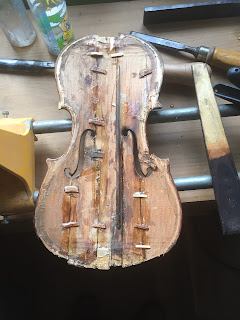In between tool rehabilitation projects and blade honing sessions, I have found some time to actually do some woodworking in the workshop. In the last two weeks, I've rebuilt a shattered 19th century violin and some broken chairs. Both were projects that were stuck in the pipeline for the best part of 5 years.
The violin is one the numerous 19th century German or Bohemian copies of Italian classics. This one was labelled as "Nicolaus Amatus" which was disproved with a cursory look at the neck. As it was unshortened, there's no way it could be older than 19th century. Funnily enough, the 20th century fake labels often have an indication of the country of real manufacture. As this one lacked that indication, and had a luthier note from repairs in 1904, it's most certainly a 19th century piece.
Let's start rebuilding it! First the two parts around the f hole needed to be glue back together.
I made new patches from riven air-dried fir, dead straight grain.
During previous repairs, 3 of the corner blocks went missing... so I made new one from riven air-dried fir. It's really nice to work with as you can simply split it to shape instead of sawing.
A round moulding plane clamped upside down in the front vise quickly adjusts the corner blocks to fit.
Shaving down the patches with a chisel
The next day
A bit further along, the top plate is back in one piece.
The corner blocks are back in place
I know, wrong clamp type for a violin but I didn't need to add a lot of pressure
Pegs and end pin inserted, however the end pin hole was too large and off-axis
End pin hole plugged, drilled and reamed.
Only missing the bridge and the strings
It won't win any beauty contest, but at least it's back to one piece now.
So I've had this set of 4 old German chairs for a while... they're dusty, mouldy, the caning is damaged or ripped in places and some are broken. I had been planning to spend a couple of evenings fixing them but never seemed to find the time. A reddit discussion on cleaning up smelly wooden furniture made me pull one of them to take pics of the simple process I use.
Take a dirty smelly piece of furniture, this chair for example.
Make a small pad from 000 or 0000 steel wool, then dip it in a BLO/Turps mix. Quickly wipe the piece of furniture with the pad and let it rest somewhere between 5 and 15 minutes. Come back with a lint-free cloth and wipe off the excess oil. If you used enough oil, all the contaminants on top of the wood will float to the top of the oil.
Doing one half at a time really shows the progress
The mortise and tenon joint in the front left leg broke at the shoulder, so I tried a fix I saw on youtube recently... wet the broken parts with hot water, then apply hot hide glue and clamp
Clamped and left alone for the night.
The next morning, after removing the clamps, the chair could support my weight without any issue. We'll see if that fix will last or if I'll need to drill out the tenon and insert a new one.
As the first chair was a success, I decided to attempt a more complicated one:
All tenons were loose, one leg was broken, and a nail went through the mortise wall.
The easy stuff first, let's glue and clamp the mortise wall. While this was setting, I soaked the broken off piece in the water of the hot hide glue pot for a couple of minutes and started gluing back the joints.
Quickly add the last bits of glue and clamp it all together. We'll see tomorrow if that worked out ok. Otherwise I'll need to drill out a pocket to insert a reinforcement dowel in the broken leg... Charles Hayward has a nice jig for that in his "Antique Furniture Repairs" book.
Talking of Charles Hayward... the post office delivered this today while I was at work:
I'll order the missing Hayward books at the end of the month then start collecting Wearing's books.


















































